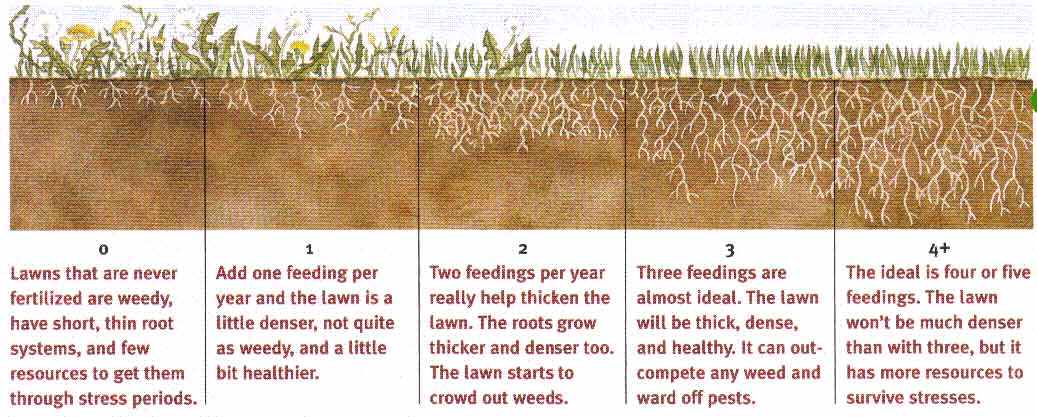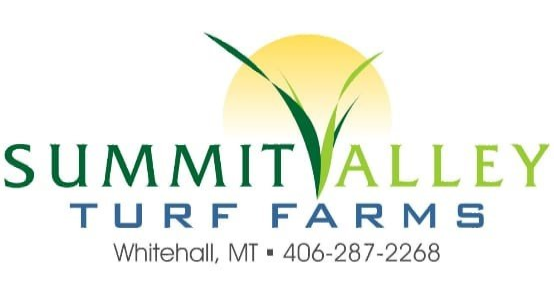Fertilizing Fundamentals
Fertilizer recommendations are based on the amount of nitrogen to provide, usually about one pound per application. An initial soil test will help you fine-tune your applications. Lawns will survive without fertilizer. However, the less fertilizer the lawn receives, the more its quality deteriorates. Don't be misled. More fertilizer is not better because over-fertilizing can be worse than none at all! It's best to split the total amount of fertilizer required annually into three to five applications and fertilize when your lawn is actively growing. Cool-season grasses put on most growth during the spring and fall. As a general rule, Kentucky Bluegrass should receive three to five feedings per year, (usually very sandy soils need more than clay soils).
To apply the right amount of fertilizer, you need to know the area of your lawn. Simply multiply Length times Width. For a lawn with an irregular shape, divide the lawn into rectangular sections and add up their areas separately.
All fertilizer packages display three numbers, the fertilizer analysis. This analysis refers to the three essential nutrients: Nitrogen, Phosphorous, and Potassium. Each number represents its percentage of the total weight. For example, a 10-pound bag of 5-2-3 would mean 5 pounds of nitrogen, 2 pounds of phosphorous, and three pounds of potassium. So you have a 15.5# bag of 29-3-4 and you want to apply 1# of nitrogen per 1,000 square feet. Multiply 15.5 by 29% and you get 4.5#. Divide that number by the number of 1,000- square foot units the bag covers-5 for the 5,000 square-foot coverage of a 15.5-pound bag. This means you will have to set your spreader to apply 4.5 pounds of fertilizer and this will deliver 9/10 pounds of nitrogen. If you don't like to mow, try using a higher quality, slow-release fertilizer. You won't see results as fast, but they won't release a surge of nitrogen and cause excessive top growth.
Fertilizing is the single most important thing that you can do for a lawn to provide it with proper nutrition. Many people feed their lawns twice a year and wonder why the lawn doesn't look all that good. That's because lawns cannot thrive on this feast or famine approach. A healthy lawn is a feast for the eyes. It has a thick and luscious color. You won't find any weeds, the blades are strong and roots are dense and spreading. The key to such beauty? Good nutrition on a regular schedule, tailored to local conditions. Grass requires a steady diet of nitrogen, phosphorous, potassium, and other nutrients. Even though many nutrients occur naturally in soil, the soil is unable to supply them in large enough quantities to meet what the plant calls for. That is why good nutrition for a lawn is the result of a balanced fertilizer program that supplies the right nutrients, in the correct amounts at the best time for the lawn.

Nitrogen

Good for:
- Growth
- Color
- Density
- Chlorophyll Formation
Deficiency Symptoms
- Pale coloring, yellowing
- Stunted growth
Good for:
- Growth of new roots & shoots
- Seedling root growth
- Seedling plant vigor
Deficiency Symptoms
- Rarely occurs
- Yellowing or purple cast to leaves
Phosphorus
Potassium
Good for:
- Growth of new roots & shoots
- Seedling root growth
- Seedling plant vigor
Deficiency Symptoms
- Rarely occurs
- Yellowing or purple cast to leaves
Good for:
- Chlorophyll formation
Deficiency Symptoms
- Yellowing
Iron

Get Started Now
To learn more about the fundamentals of fertilizing, contact us today in Whitehall, Montana.
